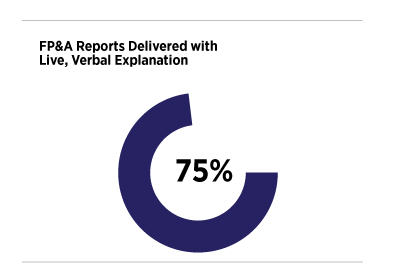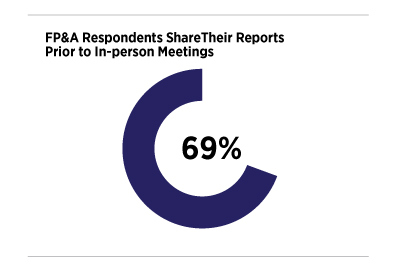Articles
Report Renovations: How to DIY an Effective Presentation
- By Bryan Lapidus, FPAC
- Published: 5/20/2022

What goes into an effective presentation? How is it different when you’re in the finance profession? At our second “Report Renovations” webinar, we asked the attendees what storytelling means to them. They responded: engagement, relatability, connection, enabling decision-making, and giving context to provide meaning. Our expert panel took this starting point and offered up suggestions on how to do it.
The importance of storytelling
Storytelling matters because in our meetings, conversations and reports, we have a message that we want the other person to understand. There are two key tasks to keep in mind when putting together a report: make it easy to identify the message, and make it memorable. Holding the audience’s attention leads to action and effectiveness.
Where do people go wrong? First, by not identifying the goal of the report — the point is to show you x, y and z.
Another way people go wrong is with the report delivery.
- Too many pages/slides in one report. When you do that, the audience isn’t able to focus on anything because they're overwhelmed with information.
- Wrong visuals. For example, using a pie chart that has 20 to 25 different pieces makes it hard to really see what's going on.
- Too much information on one slide. One attempt to fix problem 1 (too many slides) is to jam all your charts and info onto a single page, but this leaves your audience with nowhere to focus.
The answer? Have a written goal to help limit your slides — it forces you to edit.
“If you're saying, I just want to show them all the financial information, that's not a goal,” said Carmen Turner, senior financial professional and member of the AFP North American FP&A Advisory Council. “The goal needs to be specific, e.g., I want to communicate that we need to raise a million dollars because we're going to fall short by next month. Specificity leads to action.”
Ace Your Communication
.tmb-thumb160.jpeg?sfvrsn=c5d116b_1) Audience – Understand and cater to your audience.
Audience – Understand and cater to your audience.
Content – Create Insightful and impactful content using visualization.
Execution – Remember your body language and vocalization are very important.
ACE your communication
“You’re not going to reach your audience if you’re not giving them what they want in terms of how they digest information,” said Ron Monteiro, speaker, facilitator and coach at Clear Concept Inc. He created the mnemonic acronym ACE to guide his clients when creating a good story, where the first letters stands for audience. Understanding who your audience is and catering to them is critical. “I’ve prepared 30-page presentations for clients who just wanted a one-pager, and I’ve had clients who are tele-oriented and want a 30-page deck.” At some point, you have to give the people what they want.
Second is content. You want insightful and impactful content that will hold your audience’s attention. Tailor your content to audience; for example, your approach would be very different if you were communicating with a CFO versus a VP of sales. With the first you have someone who is highly knowledgeable about the financials, so you probably want to go with a detailed chart. With the other, visualizations may be more appropriate.
Third is execution. This refers to things such as enthusiasm, smiling, using your voice as a tool—the HOW you deliver in addition to the WHAT. “We're all individuals,” said Monteiro. “It's about recognizing the part of the equation you can focus on to be the best storyteller and communicator you can possibly be. As opposed to going into a really dry finance, accounting, or budget meeting, challenges yourself to make it engaging.” How do you handle that person in the room who is just visibly tuned out? Ron advises being direct: elicit feedback from the stakeholders in the moment or afterwards. How could this be more useful? Be willing to change your approach on the spot.
Find the balance between storytelling and sharing insights
Dave Paradi, owner of ThinkOutsideTheSlide.com, fears a mis-use of the term storytelling. “One of the reasons that storytelling has taken off is because it is different. It's, ‘Wow. Look at this new shiny object called storytelling. Let's do that!’ And so it's caught on and everybody seems to be jumping on this bandwagon. However, we do not need to have heroes and villains and conflict and all this story, stuff that you are going to hear out there.”
Paradi has a different term for storytelling: insights. Similar to our other experts, Paradi advises you to start by figuring out what the executives want and ensure everyone has the same context for the information. Interview your audience. Start with the metrics they pay attention to. Ask them what they look at on a daily, weekly, and monthly basis to make sure the business is on track, and for each of those metrics, what insights are they looking for?

Stop Telling Stories, Start Sharing Insights
- Figure out what executives want
- Metrics
- Insight
- Calculations (Analysis)
- Create Effective Visuals
- Use the Appendix to reduce overload
“As FP&A professionals, we have to do the analysis to come up with the insights they need to run the business,” said Paradi. Then create visuals that communicate those messages. Effective visuals are based on the message. According to Paradi, it’s also okay to have many slides — in the appendix. “Sometimes, under regulatory requirements, you have to provide certain data, so by putting it in the appendix, you can check that box.”
The bottom line is that the goal of your communication is to add value to the organization. “That's where I want people to focus,” said Paradi. “What value are you adding? Because if you are not adding value, then you are a candidate to leave the organization involuntarily.”
Sending out reports ahead of the presentation
Should you circulate your reports before the meeting? Pay attention to context: it may depends on the type of meeting and your audience. If it’s an emergency situation or the meeting or the information could be misunderstood, then no. Conversely, board meetings and periodic meetings may benefit from a pre-read.
In general, Turner says pre-reads can make meetings more efficient: “When people don’t see the information until the meeting, you can’t really get any good feedback or questions because they haven’t had time to digest the information.” Turner sends out the material and sets the expectation for the meeting to come: “I may not necessarily walk them through slide-by-slide because, but instead which areas they want to focus on and then discuss those points first.”


Copyright © 2024 Association for Financial Professionals, Inc.
All rights reserved.

.png?sfvrsn=215d116b_1)
